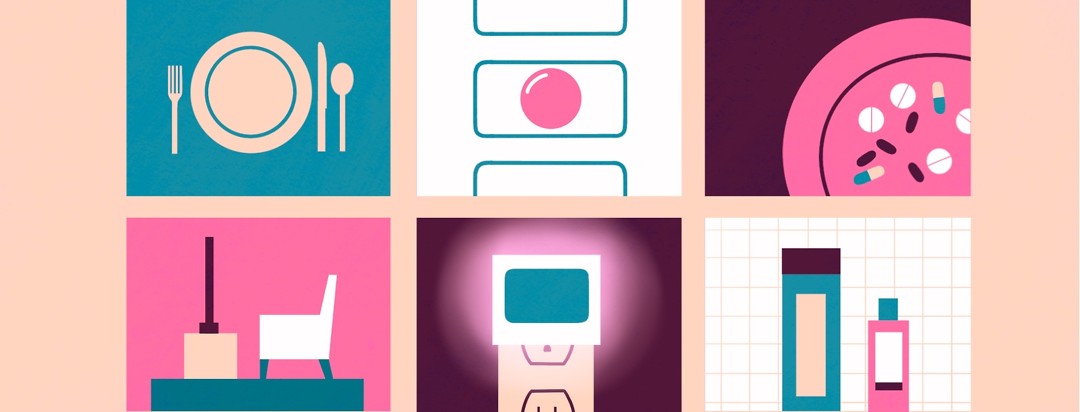Low-Tech Home Solutions
Being on speaking terms with Alexa or Siri can be a great help around the house, especially for those with vision loss. Some of us, though, are yet to make their acquaintance, let alone be on a first-name basis. Here are a few low-tech, real-world home solutions for macular degeneration that my parents found useful when dealing with macular degeneration at home.
Kitchen and dining room
We had white plates, white drawers, and a white tablecloth in the kitchen and dining room. My parents couldn’t really see what was what.
Creating contrast
Something had to change! We went to inexpensive chain stores or charity stores and bought a few different colored plates. We also used colored tablecloths and placemats and experimented with what contrast worked best. Not only did the plates have to be visible, but the food on the plates needed to be seen too.
Nothing was perfect, but most contrasts were better than nothing at all. With all this mix-and-match going on, we made sure we had a nice set of attractive matching mugs for when visitors called.
Medication
Both of my parents also organized and took their medications on the dining room table. When I visited I usually found numerous little stray, untaken, white tablets lurking on and under the white lace tablecloth. This was a further incentive to change the tablecloth to a color that would show these little escapees. We also used a bright plastic plate to put the tablets out on before taking them.
Relying on feel
Bump dots and microwave ovens are a great match. One suggestion, though, is not to use too many on any one appliance.
We decided on a bump dot on the one-minute button and the start button. Then my mother would press the minute button the number of times she needed. She knew how long it took to warm up a cup of coffee, or to heat a frozen meal, so she didn’t need a bump on the stop button. And, she could always open the door in an emergency.
Living room
We bought a new television and rearranged the living room to place the chairs closer to the television. Obvious, you might think! But I wish we had done this sooner to give them more time to get used to the new arrangement.
Rest and relaxation
We put bump dots on the television remote, but first, we worked out which buttons they could find themselves, so we minimized the number of bump dots required. The television was programed to come on to their favorite channel so that at least sometimes, they didn’t need to change anything.
A new coffee table in a color that contrasted with the carpet was another good purchase.
Simplifying phone calls
The telephone was tricky. Neither of my parents was confident with a cell phone. We had previously bought cordless landline handsets, but they couldn’t see the answer or hang-up buttons. We reverted to a large, fixed-line phone with big buttons, where you just had to lift the handset to answer and replace the handset to hang up. We programed their 3 most important contacts into quick dial keys.
Sometimes the old, low-tech ways are better for folk who haven’t grown up in the computer era.
Bathroom
A small sensor light that came on when it got dark and stayed on all night was a great help in the bathroom. Towels and face cloths in contrasting colors to the bathroom tiles were also a great success.
Shower suggestions
We even bought contrasting soap – this might have been going too far! Soap on a rope was also tried. My parents decided they didn’t want this blast from the past dangling around their necks, so this idea was discarded.
I decanted their hair conditioner into a smaller container so that they knew the shampoo bottle was big, and the conditioner was small.
We did have success with limiting the hot water temperature at the hot water system and felt safe that if the wrong tap was turned, or if a tap was turned too far, no one would get scalded.
Bedroom
We changed the floor-length bedspread for a doona (also known as a duvet or duvet-cover) and cover which didn’t drape on the floor and become a trip hazard. We also made sure that the doona material wasn’t slippery because we had had near misses when someone sat on the edge of the bed and nearly slipped to the floor.
Lamps and bedside tables
It was found that a touch lamp on the bedside table was easier to turn on and off than a lamp with a switch that was hard to find. We also organized a small supply of toiletries in the bedside drawer: eye drops, tissues, paracetamol (acetaminophen), lip balm, etc. to minimize the need to get up at night.
It's a learning process
We learnt these things by trial and error as we went along. They were all easy to implement, and I wish we had thought of some of them earlier. What may seem like little things can make a big difference.
Hopefully, our experiences will be helpful to someone else.

Join the conversation